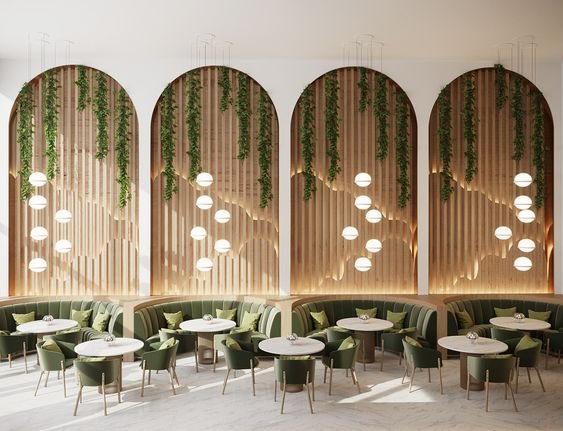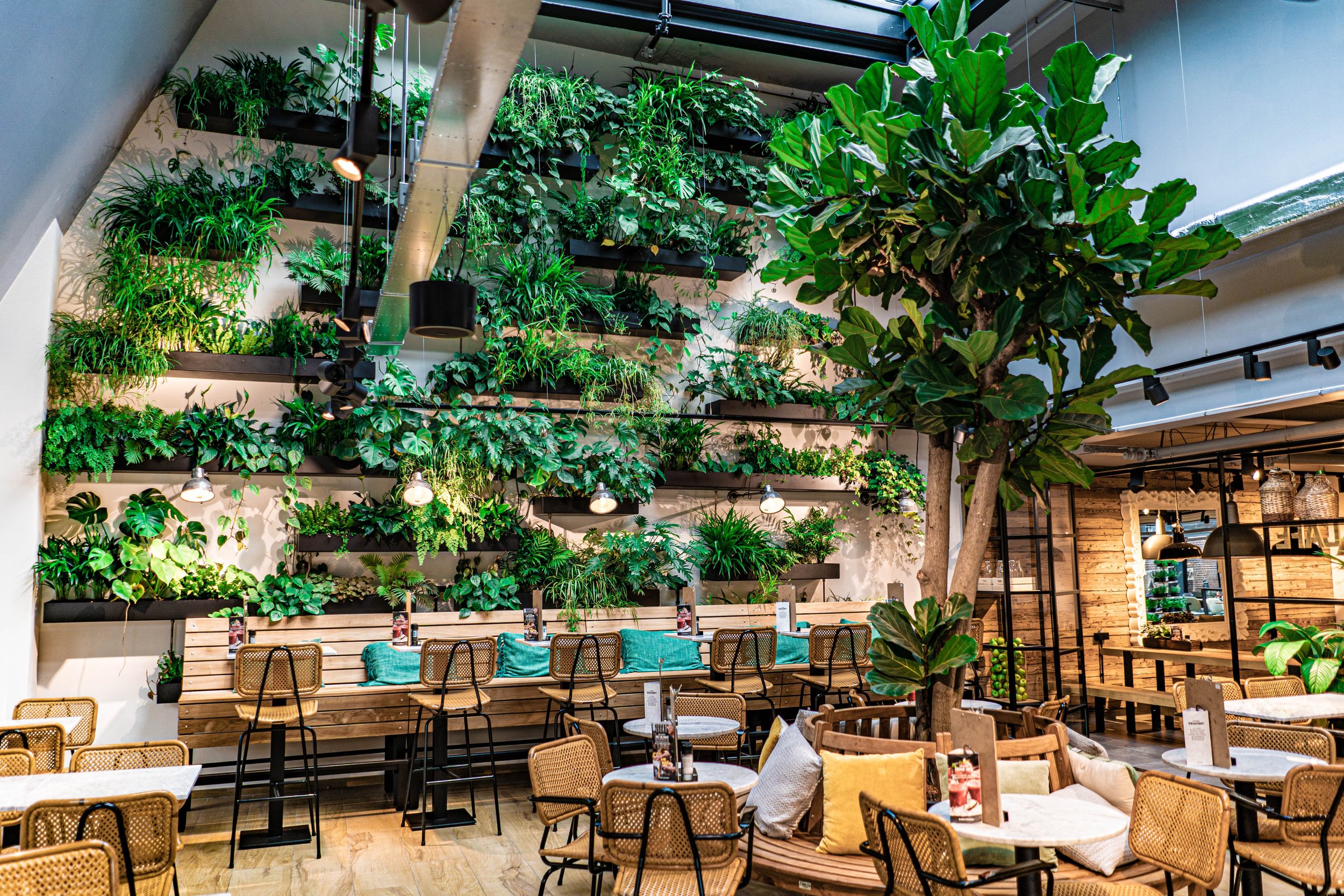Biophilic Restaurant Design: Enhancing the Human-Nature Connection
What makes a restaurant exceptional? The food, of course… but what about the experience and how you feel while dining there?
You may not realize it, but the physical experience of a restaurant really does matter.
Restaurant interior design can dictate how customers perceive the quality of the food, the level of service they expect and whether they’ll want to come back. It impacts how much they order, how long they stay and how much they expect to spend.
Strong interior design plays a crucial role in the success of any restaurant. So, why not lead with a winning design that makes guests feel calm, welcome, and connected?
At Sansa Interiors, we believe that one of the best ways to bring out that feel-good factor – and keep diners coming back again and again – is to start every restaurant design with a biophilic design approach.
What is Biophilic Interior Design?
At its core, biophilic interior design aims to connect us more closely to nature. Designers who employ this approach do so with the hope of improving our impact on the environment, positively influencing our well-being and protecting our planet for generations to come.
Well-executed biophilic design incorporates sustainable design principles that celebrate the natural world. When done well, this approach takes inspiration from nature’s beauty and interprets that beauty as design elements, creating spaces that support our emotional, psychological and physical health.
Utilizing plants and natural light, maximizing views to the outside, favoring natural materials, textures and patterns that are inspired by nature, and incorporating organic shapes are all key elements of biophilic design
Research shows that human beings have an innate need for nature and that we can feel satisfied with just a few minutes of interaction with the natural environment.
Why not fulfill that innate need with your restaurant’s design?
Here are our top four tips for tackling a café or restaurant refresh:
Plants, plants, plants… to look at and to eat!
Hands down, the number one element required for any biophilic design is plants. They’re fundamental to biophilic design principles, instantly make a space feel more deeply connected to nature, improve indoor air quality, and dampen sound, among many other benefits.
Luckily, there are plenty of ways to bring greenery into your design. Consider installations like a vertical garden or green wall, or keep it simple with potted plants or window boxes.
Whichever direction you choose, these design elements also help to create natural partitions within your space – enhancing privacy for diners and masking any unsightly exposed ducts, pipes or doorways.
And, have you considered the opportunity to grow your own food?
Introducing a functional vegetable garden out back or a hydroponic vertical farm inside are both great ways to showcase your restaurant’s expertise, and beliefs: that our planet is worth celebrating. Fill your gardens with herbs, lettuce or other veggies for regular harvesting and uber fresh salads.
The fresh fragrance will be appreciated by your guests, and they’ll love to know exactly where their food is coming from.
Taking inspiration from natural materials and textures
Biophilic design isn’t solely about plants. The entire spectrum of natural elements and experiences can be used as inspiration.
Materials like stone, glass and clay lend themselves well to a strong foundation of biophilic design, while softer materials and textures, like wallcoverings and fabric patterns that are evocative of natural elements will bring diners closer to nature. grasses or lighting Lighting and signage that beautifully filter light over the course of the passing day, will also help to enhance a diner’s experience and connection to nature.
If you have the space and budget, a well-designed water feature can also act as a cornerstone of your biophilic restaurant design. Water is significant from an elemental perspective and helps to create both visual and auditory focal points.
Most importantly, building materials that are good for the environment are a requirement for any biophilic design. Where possible, incorporate a green roof, sustainable energy sources and carbon-neutral materials to honour our planet. Interiors that nourish the earth and our souls are good for everyone!
Organic lines for comfort and intimacy
When taking a biophilic design approach for your restaurant or cafe, form is another important factor to consider. While convenient and efficient for building, the straight lines of traditional construction don’t always lend themselves to creating a space inspired by nature.
Instead, opt for curvilinear forms that create intimate spaces, encourage air flow and enhance site-lines through the space. The resulting design will hold a natural sense of layering often found in nature.
Organic forms also help to curb sound travelling through a space. The resulting ambient noise becomes softer, calmer and much more pleasant. You can also choose to incorporate finishes such as rich, textured upholstery, live moss, privacy booths, and soft, eco-friendly floor panels that reduce ambient noise even further. Did you know that a living wall can reduce noise by 20 – 30%? It’s true!
Using organic forms and curved lines also creates a unique opportunity to curate the view through your restaurant. Allow the architecture to guide your guests along a welcoming and meandering journey from the moment they walk in – an exceptionally sensory approach to design.
View from the indoors out
Diners are more interested in where their food comes from now than ever before, why not capitalize on the opportunity to not only tell them, but show them.
If your location allows, foster an authentic connection to the local environment by opening views to the outdoors, showcasing the land (or green roof) that produced the food your restaurant is serving.
If you’re located in an urban area, even a quaint patio can become a biophilic design dream. Use local varieties of plants that flower or bloom throughout the year to create the sense of connection to nature that your diners will love.
Appealing outdoor space not available to you? Creative ways to connect to the outdoors can be just as effective as the ideal view. If looking out onto the street is too unsightly, consider using clerestory windows or skylights to let the natural light shine in and connect diners of the sky above. Or, place large planters in the front windows to obscure the hustle and bustle beyond, while offering a lush, private get-away for your guests.
A strong connection to the outdoors also helps with natural air flow, change of energy and allows natural light to fill the space – much better on eyes, minds and hearts than harsh artificial light.
Final Thoughts: Biophilic Restaurant Design
In the end, we believe it’s the restaurateurs who prioritize creating a space that expresses their core values – sustainability, local, comfort, hospitality – who’s restaurants will flourish. Why not make those beliefs abundantly clear in every aspect of your business?
By strategically and creatively incorporating plants, natural materials and inspiration from nature, you can create an exceptional restaurant that will keep diners coming back again and again.
Not sure where to start? Sansa Interiors can help! Let us design and build the inviting, nature-inspired restaurant of your dreams.
Article by Laura Zarnke, Writer and Content Strategist.
Looking for an Interior Designer in Toronto?
Are you looking to turn your restaurant or cafe into a harmonious, inviting and nature-inspired locale? We can help! Our team serves Toronto, Etobicoke, Mississauga, and the rest of the Greater Toronto Area. Contact us via our website to find out more about how we can help to connect your customers to nature through design.










